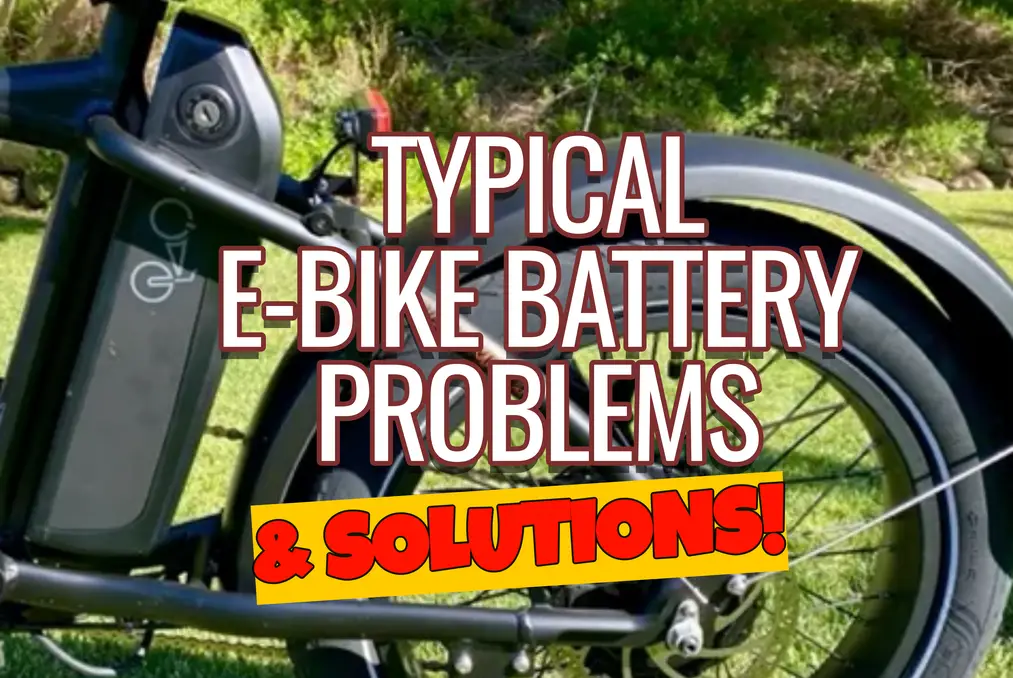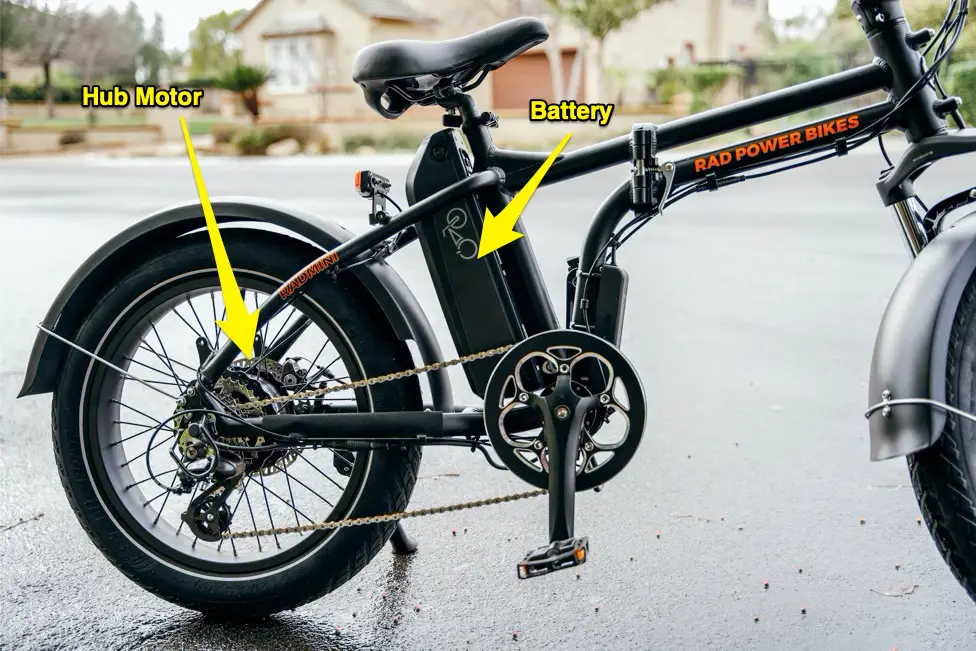All e-bikes are powered by batteries, and if you own one, you’re likely to run into common issues with the battery pack from time to time. Some problems may occur due to normal wear and tear, but batteries also have a limited number of charge and discharge cycles. Other problems, like failing to charge fully or refusing to turn on, can be fixed by checking the ports and allowing your battery to charge up to 100%.
In general, there are six typical electric bike battery problems that you may face:
- The battery fails to fully charge
- It swells up or bulges
- It’s not running as long as expected
- E-bike refuses to turn on
- The battery is not holding a charge
- Sluggish battery performance
Although many problems have a solution, it’s also possible that you’ll need to replace your battery pack.
So, continue reading… this article will discuss in-depth some of the most common e-bike battery issues while also providing possible solutions for them. Be sure to see the step-by-step diagnoses table as well.

Typical E-Bike Battery Problems And Solutions You Should Know About
Electric bikes certainly have more problems than regular bikes due to the motor and battery pack. Although problems are not all that common, they can creep up and make your e-bike experience a little annoying.
However, if you recognize the problems and understand how to deal with them, you can enjoy your e-bike fully. So, in this section, I’ll tell you the six most common problems e-bike owners might face with their batteries. And I’ll show you the possible solutions for each of them.
You can breathe a sigh of relief though. Some of the problems are things you won’t even have to deal with if you take proper care of your e-bike. And later on, I will tell you some best maintenance practices to help you get the most out of your electric bike.
Let’s get started then. There are six typical ebike battery problems to consider.
1. Battery Fails To Charge
One of the most common e-bike battery problems is that it might just fail to charge. Therefore, your electric bicycle motor won’t run at all. Unfortunately, this is also one of the most difficult problems to properly diagnose.
This is because failure to charge can be caused by a couple of things. You might want to have a checklist of the things you want to test to ensure everything is plugged in the way it should.
How To Fix a Battery That Won’t Charge
There are a couple of solutions to fixing a rechargeable battery that’s not charging. Most of these are just normal troubleshooting steps. First, you need to check whether or not everything is plugged in right.
Step One- Double-check that the battery terminals are connecting to the electric bike. If they are off just a little (or they’re not clean), then that would explain why the battery pack is not working.
Step Two- Check the voltage that is coming out of both your wall socket and the battery charger. Use a multimeter or voltmeter like these ones on Amazon.
Step Three- Make sure the charger is not at fault. Plug it in and look for the indicators to light up (or attempt to charge your battery completely).
If you determine that the charger voltage is lower than the specified voltage for your ebike battery, then the charger will not be able to pull as much power to charge your battery. You should also try and clean the charger ports as well. Dirt and debris on the battery pack charger port can stop it from making a solid connection.
For help checking your battery voltage, take a look at this YouTube video:
2. Battery Swells Up
If you had a phone for a long time, you might have experienced a swelling-up problem. Modern batteries are made from lithium-ion, and most electric bikes have lithium-ion batteries as well. Although the battery management system in these batteries are pretty durable and can last for up to 700 charging cycles, in some cases, they can also swell up prematurely.
If you see a swollen lithium-ion battery, then the problem is somewhat severe. One or more of the lithium cells could be the problem. Thus, there may not be anything you can do to fix it.
So, what should you do if the battery on your electric bike has swollen up?
How To Fix a Swollen Battery
Well, the only ‘fix’ in this case is to replace and recycle the battery pack. A bulge on the battery should be very noticeable. If you see one, turn your e-bike off and disconnect the battery. It is a huge risk to continue using a swollen battery as it can be very dangerous, leaking hazardous gases and fluid.
Unfortunately, for a swollen battery pack, the best thing to do here is to get a new one, as the entire battery management system has likely been damaged. Stop using it immediately and give it to your local recycling center.
Then replace the old one with a battery of the same size and voltage. Refer to the electric bicycle brand you purchased from for assistance.
3. Battery Is Not Running As Long As It Used To
The third common problem with e-bike batteries is that they might not hold onto a charge as long as they should. Typically, electric bike batteries have a limited number of charge and recharge cycles. What this means is that there is only a finite number of times you can fully charge the battery and discharge it before it loses its optimum capacity and performance.
You might have seen Apple tell you the battery health percentage on their iPhones. This number essentially tells you how well the battery is performing. The lower the percentage is, the lower the quality of the battery. A degraded battery will not hold a charge for as long as it used to.
This is the same for an electric bike lithium-ion battery. Even though a high-quality battery should last around 700 charging cycles or more, it will degrade over time and not go far on one charge. If it is degrading, you might even feel some resistance when pedaling.
Further, many e-bikes have advanced features like pedal assist or throttle that provide a speed boost. These will eat away at your battery charge quickly the more you use them.
How To Fix a Degrading Battery
Sometimes, a degrading battery packmight not be the only reason your battery is not holding its charge for long. However, there are things you can do to diagnose the problem and fix it.
First of all, check whether or not the battery charges fully. If it doesn’t, then that will give you a clear indicator that something is wrong. Second, are you using your battery extensively when riding your e-bike? If so, avoid using the throttle and pedal assist system except when you truly need them, like climbing a steep hill.
Speaking of this, an uphill route can also cause your battery to discharge quicker, as it’s simply more strenuous.
Finally, the wheel bearings should spin freely and smoothly. If they are not, that means that there is something wrong and your battery is working harder than it needs to. Thus, the battery is discharging quicker than it should.

4. Electric Bike Refusing To Turn On
Sometimes your electric bike might just refuse to turn on completely. Do not panic though. Yes, there might be a problem, but there is also likely a good solution.
After all, e-bike batteries don’t just work by themselves, but rather along with the different components such as the motor and controller. The problem could be with other parts of your electric bike not working, rather than simply your battery.
For example, a speed controller sends signals to the battery and the motor, letting them know that it needs to start working. Other components (like a fuse blown) are also pretty important.
How To Fix It
If your battery is not turning on at all, you need to check these things to ensure that they are all okay.
- The fuse may be blown.
- There could have been a short circuit in the wiring (or just degradation over time).
- The speed controller could be damaged if the electric bike was dropped or suffered water damage.
- Moisture may have gotten in and destroyed the wiring. A good solution here is to try to force the speed controller to turn on by pressing and holding the power button for 10 seconds or so.
- Your charge levels may be very low, not allowing it to turn on (even if the charge level is 5 – 10%, there can be trouble). Charge it till you see at least two to three bars and try again.

5. Battery Not Holding Charge
As I have mentioned, all batteries have a life cycle. They are not magic and will not run forever.
The reason for this is likely just due to casual wear and tear. Over time battery cells will naturally lose their ability to hold onto charge. This is because as the cells inside the batteries get older, they stop performing at their peak.
So, the problem could just be an old battery or it could be the electric bike itself.
How To Fix An Old Battery
Unfortunately, if the problem is just because of an old battery that has gone through its natural wear and tear. So, there is not much you can do about it. It’s best to get a new battery. Or you might choose to refurbish the battery, if you have experience doing so or are willing to have a bike technician do it.
However, before you head out to the store, there are a few diagnostic steps you can take.
First, try charging your battery to 100%. Just recalibrate it and see how it holds onto a charge. If you have not used your e-bike in a while, charging it all the way can help. Another thing you can try is to charge the battery and take it off your bike.
See how long it holds onto the charge. If it holds onto the charge longer, then the problem might be with your ebike. Your bike might have a short circuit in it that is causing the battery to drain faster. In this case, the best solution is to take it to a shop to be fixed or replace the battery with the same type.
6. Sluggish Battery Performance
A sluggish ebike is no fun. It will feel very dull to ride, almost as if you’re riding a standard bike. When this happens, sometimes the issue can be the battery. This is one of the most common wrongly diagnosed battery problems in an e-bike. However, there are some diagnostic steps you can take to try and fix it.
How To Fix Poor Battery Performance
Good e-bikes will have a switch. These are located on the front and rear brakes. The switches can fail, causing your bike to move slowly. The first solution is to try pulling both brake levers at the same time. This can free up one stuck brake lever.
You should check the limit switch as well. That might be faulty. Fixing that should get your bike up to speed in a jiffy.
E-bikes also have different riding modes including pedal assist, throttle only, and other modes. Check to see if you are using the right mode for when you need top speed. In some cases, the problem might not be your battery but rather the mode and the settings.
How to Know if Your E-Bike Battery is Bad
Given all of the potential problems and solutions to a bad battery, your first step should be to diagnose the problem. You’ll need a multimeter or voltmeter for a proper diagnosis.
Here’s a chart covering the general step-by-step diagnosis of your battery problem.
| Step 1 | Make sure you’re using the correct battery charger for your electric bike |
| Step 2 | Make sure the battery connectors are lining up with the charging pins |
| Step 3 | Attempt to charge the battery fully |
| Step 4 | Test the battery charger for its voltage output using a multimeter (and look to see if the indicator lights are working) |
| Step 5 | Test the battery with a voltmeter or multimeter (the e-bike’s display should light up) |
| Step 6 | Look for loose wiring: A loose connection may prevent the battery from receiving or providing it’s full charge capacity |
If you can diagnose the problem first, you’ll have an easier time finding a solution.
Need more help diagnosing a bad battery? Take a look at this YouTube video:
How to Take Care Of Your Electric Bike Battery
While some issues are inevitable, like wear and tear, other issues can be resolved. But no matter what the problem is, you don’t want to end up with a dead battery while riding. But, you can prevent this by providing your e-bike with good care. With proper maintenance, you can extend the life cycle of your e-bike battery pack to keep it working as long as it is expected to.
Here are a few battery maintenance tips to keep your battery in good shape. Don’t worry, these are pretty easy to do and won’t take much effort. You just need to be mindful of a couple of things.
- Store your electric bike properly: Keep the battery in a cool place indoors where it won’t get wet or be susceptible to moisture buildup.
- Avoid extreme temperatures: Preferably, keep your battery in a place under 100 degrees Fahrenheit and above freezing conditions.
- Always use the correct battery charger, preferably the one that came with your e-bike.
- Don’t let your battery overheat. Riding your electric bike will cause it to warm up, which is normal, but you should avoid leaving the battery exposed to the direct sun or in a hot location.
- Try avoiding deep discharges. That is, don’t let your battery charge fall below 10% when possible. Recharge it as soon as possible, rather than letting it remain without a charge.
Read this article for 15 helpful battery charging tips!
Wrapping Up
Now that you have made it to the end of the article, you should be able to diagnose typical e-bike battery problems and use some of the solutions provided. Be sure to follow the above steps to help you.
In some cases, there isn’t a quick fix and you’ll just need to replace it. But proper maintenance will help you prolong your electric bike’s battery life.
Check out these other articles about batteries and common e-bike problems:




